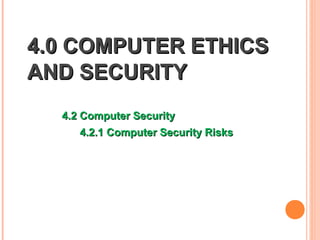
3.2.1 computer security risks
- 1. 4.0 COMPUTER ETHICS AND SECURITY 4.2 Computer Security 4.2.1 Computer Security Risks
- 2. LEARNING OUTCOMES: At the end of this topic, students should be able to: Define computer security risks. Identify types of security risks. 2
- 3. DEFINITION Computer Security Risks Definition : is any event or action that could cause a loss of or damage to computer hardware, software, data, information, or processing capability. 3
- 4. Types of Computer Security Risks
- 5. Types of Computer Security Risks Internet and network Internet and network attack attack Unauthorized access and use Unauthorized access and use Hardware theft Hardware theft Software theft Software theft Information theft Information theft System failure System failure 5
- 6. Internet and network attacks • Information transmitted over networks has a higher degree of security risk than information kept on an organization’s premises.
- 7. 1. Malware 1. Malware 5. Spoofing 5. Spoofing Internet and network attacks 2. Botnets 2. Botnets 4. Denial of service attacks 4. Denial of service attacks 7 3. Back Doors 3. Back Doors
- 8. Malware Malware (malicious software) – which are program that act without a user’s knowledge and deliberately alter the computer operation. Type of malware: i. Computer viruses ii. Worms iii. Trojan Horses iv. Rootkit v. Back door vi. Spyware
- 9. Malware Symptoms Malware •• Operating system runs much slower than usual • Available memory is less than expected • Files become corrupted • Screen displays unusual message or image • Music or unusual sound plays randomly • Existing programs and files disappear 9
- 10. Malware Symptoms Malware • Programs or files do not work properly • Unknown programs or files mysteriously appear • System properties change • Operating system does not start up • Operating system shuts down unexpectedly 10
- 11. Malware 1. Worm Definition : Worm is a program that copies itself repeatedly, for example in memory or on a network, using up resources and possibly shutting down the computer or network. 11
- 12. Malware 2. Computer Virus Definition : Computer virus is a potentially damaging computer program that affects, or infects, a computer negatively by altering the way the computer works without the user’s knowledge or permission. 12
- 13. Malware 2. Computer Virus it can spread throughout and may damage files and system software, including the operating system. 13
- 14. Internet and network attacks Malware 3. Trojan horse Definition : Trojan horse is a program that hides within or looks like a legitimate program. It does not replicate itself to other computers. 14
- 15. Internet and network attacks Malware 3. Trojan horse it can spread throughout and may damage files and system software, including the operating system. 15
- 16. Internet and network attacks Malware 4. Rootkit Definition : Is a program that hides in a computer and allows someone from a remote location to take full control of the computer. The rootkit author can execute programs, change settings, monitor activity, and access files on the remote computer 16
- 17. Internet and network attacks Malware 5. Spyware & Adware Spyware is a program placed on a computer without the users knowledge that secretly collects information about the user. Adware is a program that displays an online advertisement in a banner or pop-up window on web pages, e-mail messages or other internet services 17
- 18. Botnets Definition : a group of compromised computers connected to a network such as the Internet that are used as part of a network that attacks other networks, usually for nefarious purposes.
- 19. Back Door Definition : A program or set of instructions in a program that allow users to bypass security controls when accessing a program, computer, or network
- 20. Denial of Service Attacks Definition : Denial of service attacks or DoS attack, is an assault whose purpose is to disrupt computer access to an Internet service such as the Web or e-mail.
- 21. Spoofing Definition : A technique intruders use to make their network or Internet transmission appear legitimate to a victim computer or network.
- 22. Unauthorized Access and Use Unauthorized access The use of a computer or network without permission. Unauthorized use The use of a computer or its data for unapproved or possibly illegal activities.
- 23. Hardware Theft and Vandalism Hardware theft Is the act of stealing computer equipment. Hardware vandalism The act of defacing or destroying computer equipment.
- 24. Software Theft
- 25. Information Theft Occurs when someone steals personal or confidential information. If stolen, the loss of information can cause as much damage as (if not more than) hardware or software theft.
- 26. System Failure A system failure is the prolonged malfunction of a computer A variety of factors can lead to system failure, including: Aging hardware Natural disasters Electrical power problems Noise, undervoltages, and overvoltages Errors in computer programs